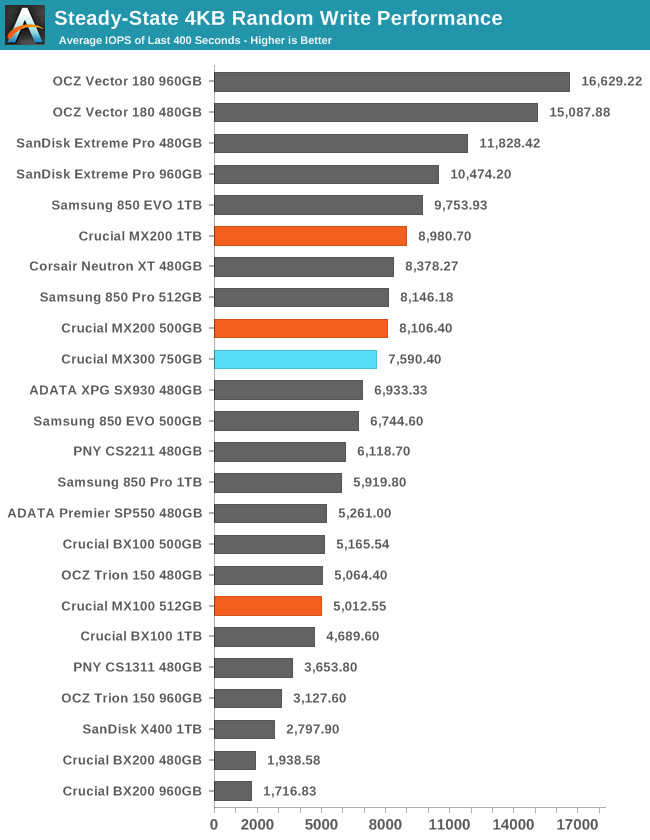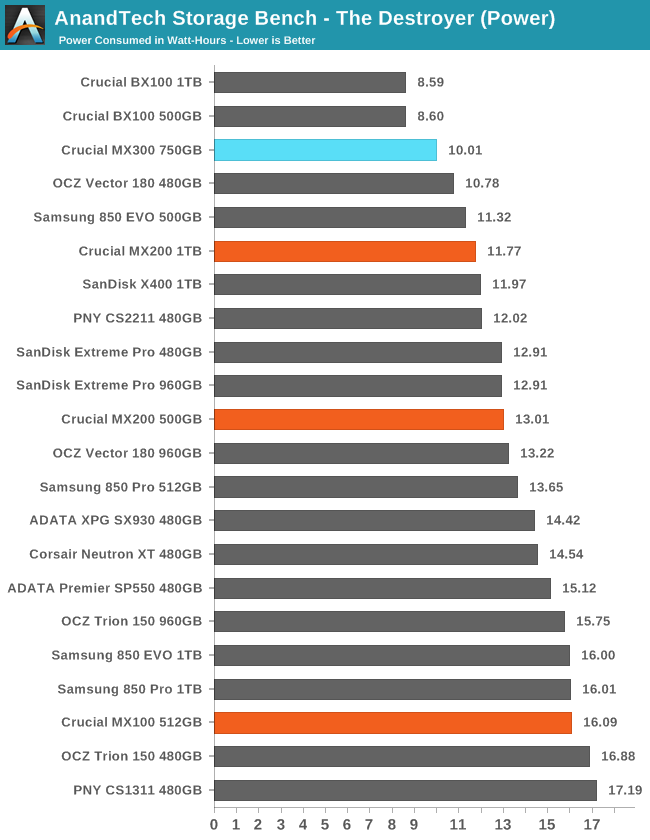Crucial Expands MX300 SSD Lineup with Additional Capacities: Up to 1TB
by Anton Shilov on August 2, 2016 2:00 PM EST
Crucial this week made two announcements. Its MX300 family of 3D NAND-based consumer-grade SSDs has been expanded with additional models, and also Crucial revealed plans to start sales of its MX300 drives in the M.2 form-factor. The family of affordable SSDs now includes models with 275 GB, 525 GB, 750 GB and 1 TB of usable NAND flash. In addition, Crucial intends to roll out a 2 TB version of its MX300 in the near future and has already disclosed its specs.
The Crucial MX300 SSDs are based on the company’s first-generation 32-layer 3D TLC NAND as well as Marvell’s 88SS1074 controller. Just like other MX-series drives, the new devices fully support encryption, pseudo-SLC caching for faster writes, partial power loss protection and a three-year warranty. We reviewed the 750GB version of the MX300 earlier this year, and you can read the review here.
Due to the 384 Gb (48 GB) capacity of Micron’s 3D TLC NAND, the configurations of actual SSDs seem somewhat unusual, but Micron has stated this does not affect performance or endurance of the novelties. According to the manufacturer, the MX300 drives support sequential read performance up to 530 MB/s as well as sequential write performance up to 510 MB/s (which is in line with affordable TLC NAND-based drives). The SSDs are also rated for up to 92K/83K random read/write IOPS.
| Crucial MX300 Series Specifications | ||||||
| Capacity | MX300 275 GB |
MX300 525 GB |
MX300 750GB |
MX300 1 TB |
MX300 2 TB |
|
| Form Factors | 2.5", M.2 | 2.5" | 2.5", M.2 | 2.5" | ||
| Controller | Marvell 88SS1074 | |||||
| NAND | Micron 384 Gbit 32-layer 3D TLC | |||||
| DRAM | unknown | 512 MB | unknown | |||
| Seq Read | 530 MB/s | |||||
| Seq Write | 500 MB/s | 510 MB/s | ||||
| 4K Rand Read | 55K IOPS | 92K IOPS | ||||
| 4K Rand Write | 83K IOPS | |||||
| DevSleep | 4mW | |||||
| Slumber Power | 75mW | |||||
| Max Power | unknown | 5.2W | unknown | |||
| Encryption | TCG Opal 2.0 & IEEE-1667 (eDrive) | |||||
| Endurance | 80 TB | 160 TB | 220 TB | 360 TB | 400 TB | |
| Warranty | Three years | |||||
| Price (2.5") | $69.99 | $129.99 | $189.99 | $259.99 | unknown | |
Back in April, Crucial introduced its limited edition MX300 750 GB SSD (which we reviewed) and this week it expanded the family with 275 GB, 525 GB as well as 1 TB models to address different segments of the market. The currently available Crucial MX300 drives come in a 2.5”/7mm form-factor with a SATA interface, with an M.2 version coming later in August for the 275 GB/525 GB/1 TB models. A good news is that the forthcoming MX300 M.2 drives promise to deliver the same performance and endurance as the 2.5-inch drives.
As for pricing, the 275 GB, 525 GB, 750 GB and 1TB 2.5-inch versions of the MX300 from Crucial will be available for MSRP of $69.99, $129.99, $189.99 and $259.99 respectively (note that the 750 GB version is $10 cheaper than launch). Prices of the MX300 M.2 drives, as well as MX300 2 TB SSDs, are not set yet.
Source: Crucial












9 Comments
View All Comments
Samus - Tuesday, August 2, 2016 - link
Why are Crucial drives progressively getting slower generation after generation. It seems like the last performance drive they made was the M550/MX100. The BX100 was a surprise hit too. Everything released in the last 2 years has been disappointing from a performance and price perspective.Crucial\Micron drives have proved reliable for my clients but they are hard to justify based on that alone when Sandisk, Mushkin and OCZ are releasing faster, cheaper, just-as-reliable drives, and Samsung is just killing them in performance.
It feels like they've thrown in the towel.
heffeque - Tuesday, August 2, 2016 - link
Thinking the same thing :-\DivenTech - Monday, October 24, 2016 - link
They focused on endurance. MX200 1TB is 320TBW and now MX300 is 360TBW. Read/Write speed is instantaneous and our computers doesn't usually run at peak speed 100% of the time (except for servers that uses other type of HDD/SSD). You would not notice 10MB speed difference at this range of hard drives - and will be limited by interface (6GBps) anyway.modulusshift - Wednesday, August 3, 2016 - link
Whoa, wait, there's this: https://amzn.com/Crucial-MX300-275GB-Internal-Soli...So that means that M.2 has same MSRP as 2.5"?
Samus - Wednesday, August 3, 2016 - link
Wow, nice find. And look at all those capacitors! Rare to see on a m.2 drive.Jay77 - Wednesday, August 3, 2016 - link
The 750GB makes a good Steam drive. Amazon had it on their Pi-Day sale for $140, it won't be the last time you see that price. What's troubling though, it seems Micron has cancelled the NVMe TX3, all mention of it has disappeared from their websites. It may be that the Silicon Motion controller has problems - the numbers don't look good.m16 - Wednesday, August 10, 2016 - link
That 3d technology is slower if you want it to be reliable. That's perhaps the price to pay (which I will gladly pay) for reliable consumer grade SSDs. The other option is buying enterprise SSDs but they're not reliable if they're not going to be on for an extended period.That being said, I do like their newer cheaper offerings, and as someone else pointed out here, you do not need windows to update the firmware and their partial power loss is bad ass if you do not run a UPS on your desktop (Also recommended for most quicker enterprise offerings). They can also be used for the enterprise, but they're for a very specific target (OPAL encryption for workstations and 1 TB offerings for certain servers)
I've been running their stuff for a long, long time and I can't recommend them enough for home use. Their support and quality is top notch.
They also seem to support their firmware a bit longer (at least 6 months into the next generation of SSDs) and their SSD ram caching system is mega solid.
allseasonradial - Saturday, September 17, 2016 - link
Not an expert, so I wonder how the 525 Crucial drive compares with other brands in power draw? I'll probably stick it into an older (late 2009) Macbook, which already doesn't offer a lot of (brand new) battery time. I've been reading that some SSDs actually draw more power in either of their states than some mechanical drives.